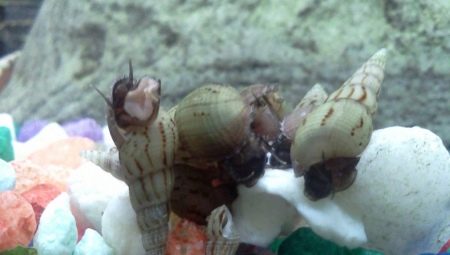Snail melting causes conflicting feelings among amateur aquarists. On the one hand, this species fulfills a rather important mission in the tank for loosening bottom soil and destroying waste and algae. But they often appear in the tank uncontrollably - with a substrate or transfer from another aquarium, and uncontrolled reproduction and incredible fecundity of the species can lead to a real invasion of snails. And yet, many have this pet on purpose and are completely satisfied with it.
How to make a living snail melania safe for the environment in which it is populated? How will a novice aquarist find it useful to describe the grapplers and other species of this inhabitant of the underwater world? Before you start a pet with a controversial reputation, it is worth studying in detail all the information about him.
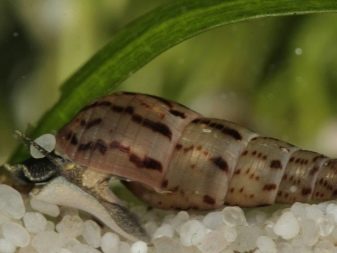

Features
The snail melania belongs to gastropods and lives in the natural environment in South Africa, but today it can be found in warm bodies of water on almost all continents - from Asia to Australia. This genus belongs to the Thiardale family, and was previously known as a tiara among aquarists and in professional literature. Still melanias are sometimes called soil snails.
The description of representatives of this genus testifies in sufficient detail to its features. Adult individuals have a body length of up to 3 cm, newborns are difficult to consider - they are no more than a grain of sand in the ground. As a matter of fact, small sizes are the culprits of the fact that melania is brought into the aquarium with soil or when buying new fish.
Mollusks have a hard shell of narrow or conical shape.The color is as discreet as possible, neutral - dark gray, yellow-green, with pronounced dark stripes.
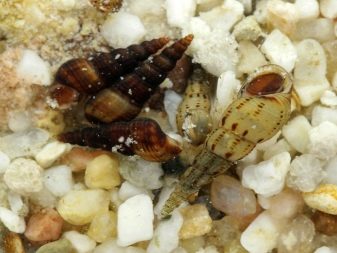
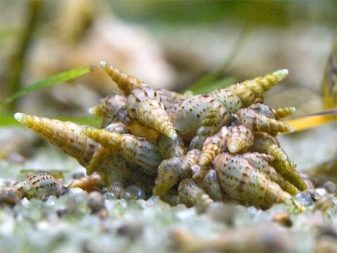
The following can be attributed to the characteristics of snails of the genus melania.
- The preferred habitat is fine river sand with fractions up to 4 mm in diameter. In coarse soil such snails do not live.
- Mostly nocturnal. During daylight hours, mollusks prefer to be in the sand at the bottom of the aquarium.
- Thermophilic. The optimal living environment should have a temperature above +22 degrees Celsius.
- Fertility. The population grows as quickly as possible and, as it grows, produces many organic compounds in the soil, worsening living conditions for other inhabitants.
- Gill breathing. Unlike other snails, chalking is sensitive to the amount of oxygen in the water. If O2 is not enough, the mollusks are massively selected from the soil. In fact, their behavior can determine the level of increased water pollution.
- Live birth. Snails carry pregnancy without laying eggs.
All these factors make melania adaptable enough to various environmental conditions. They survive and quickly increase population in any environment.
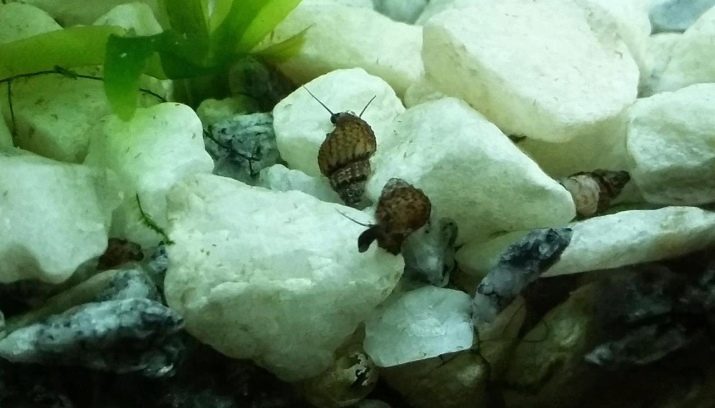
Benefit and harm
The pros and cons of keeping snails melting aquarists are well known. Their useful properties include:
- loosening of the soil, preventing its acidification, drainage of the substrate does not allow hydrogen sulfide to contaminate the aquarium;
- removal of organic and food waste from the aquarium, their processing;
- water filtration with the destruction of green algae and other microorganisms;
- the absorption of calcium from water, which makes the medium less rigid;
- indication of water quality - when it worsens, the snails crawl to the surface.
Not without flaws. In large numbers, the expanded mollusks produce more organics than they are processed.
Parasites spread in water, the general condition of the environment worsens. Having studied the benefits and harms of soil snails, we can evaluate the feasibility of their maintenance in the aquarium. In this case, the appearance of the mollusk will not come as a surprise.

Kinds
It is known that snails of the genus melania have two subspecies - Melanoides granifera and Melkanodes tuberculat. Granifera is more decorative, lives in nature in Malaysia. Her leg is gray, the shell is decorated in brown and burgundy tones - such a contrast looks decorative and interesting, which is why this subspecies is more popular.
Snails melting tuberculosis are larger, from 3.5 cm long, have a different shell color. Otherwise, the two subspecies are practically the same. Scientists also mention the third option - Melanoides riqueti, seen in the waters of Singapore. But it has too much resemblance to Melanoides tuberculat and has not yet been isolated.
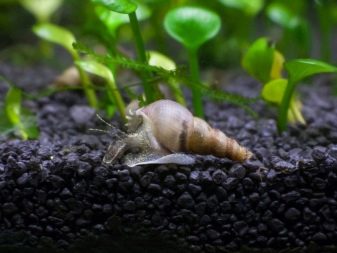
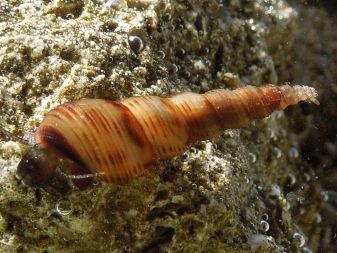
How to choose?
When choosing a snail for keeping in an aquarium, you have to choose between granifer and tuberculate. In fact, we are talking only about the personal preferences of the owner. The tuberculate shell is more pointed, decorated in gray-olive tones. The snail itself can grow up to 7-8 cm, but most often its size does not exceed 3 cm.
The granifer is painted more brightly and as a whole looks interesting, decorative. She has a more domed shell, covered with stripes. The behavior of the snails of this subspecies is also different. They are much slower and spend more time on the surface, examining the selected territory, actively master driftwood and stones.
Granifers have a pronounced territoriality, prefer not to leave the occupied habitats.
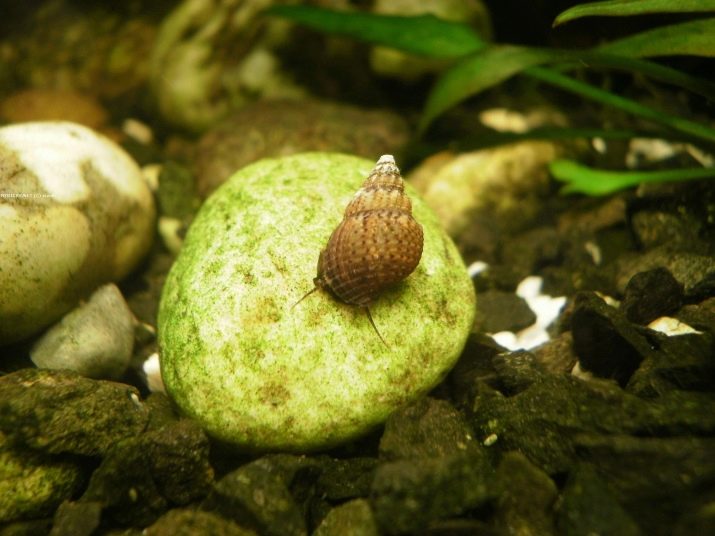
Content Rules
The maintenance of a snail melania in the aquarium does not require the creation of special conditions. This genus is as unpretentious as possible, easily adapts to living in any tank of any size. But the South African origin still makes itself felt - in a too cold environment, these thermophilic mollusks do not live.But the stock of endurance in melania is impressive - it is able to coexist even in the same aquarium with fish that feed on snails, thanks to a solid, durable shell.
These inhabitants of the water world spend the bulk of their lives burrowing deep into the ground. So it will not be easy for predators such as tetraodon to get them. By launching chalking in the aquarium, you can prevent acidification of the substrate. But on the walls of the tank you can see them except at night. In addition to sand, snails feel good in fine gravel, are not afraid of acidic and hard water. But they need an intensive supply of oxygen, the aquarium should be equipped with an aerator.
Melania snails willingly fasten on the surfaces of the scenery. If ceramic shards, pots, locks, snags are placed at the bottom of the aquarium, they will be active in exploring these objects. In addition, it will be useful to plant plants with strong roots, hard leaves. They do not represent nutritional value for snails.
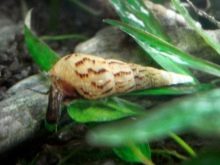
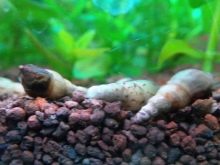
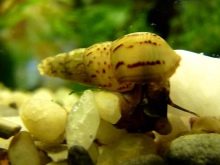
Feeding
Feeding snails in the aquarium also does not require special efforts. They are content with food debris that settle to the bottom, feed on small soft algae, representing a serious biological hazard. If it seems that food is not enough for them, you can treat them with ready-made dry tablets for catfish, slightly blanched and finely chopped vegetables.
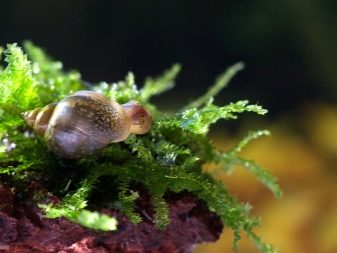
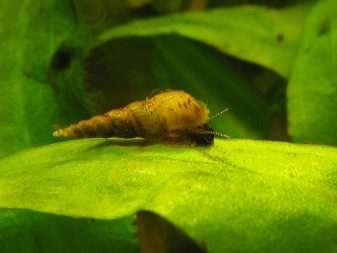
Reproduction and control of the population
Melania is a species of live-bearing snails and carries an egg inside until the offspring is ready to be born. Kids immediately after birth burrow into the ground. The number of newborns is 10-60, depending on the age and size of the mother herself. You don’t have to specially breed melania, they completely cope with this task on their own.
The growth rate of chalking is about 5 mm per month. With a lack of nutrition, this process proceeds even more slowly. The size of an adult snail reaches 6 months.

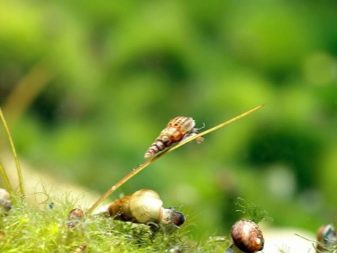
How to get rid of the aquarium?
If melanias multiplied uncontrollably, you should make sure that their number decreases slightly. Otherwise, the mollusks will obscure the light, flooding the glass of aquariums, and interfere with the operation of the filters. The use of special chemicals will help prevent their accidental entry into the container. But if you do not plan to completely get rid of snails, you will have to otherwise control the size of the population.
The first reason for the intensive reproduction of chalking in the aquarium is too plentiful food. If the waste has accumulated in the soil, it is worth siphoning it, removing the excess. Catching and freezing extra animals will also help. You can do this by simply placing a blanched sheet of cabbage on a plate on the bottom of the aquarium overnight. In the morning it will be possible to collect the "crop" and destroy it. You should not let the captured melting into the toilet - they are quite capable of crawling out of the sewer to the surface.
The natural enemy of soil snails is another mollusk - helena. It is a predator with a striped yellow-black shell. He eats smaller brothers, looks very attractive, helps to control the number of potentially dangerous inhabitants of the aquarium.

About snail milaniya see in the next video.
